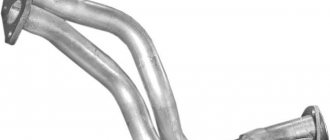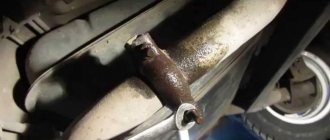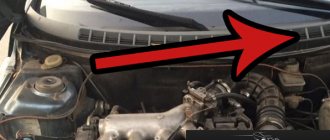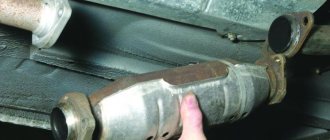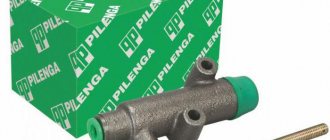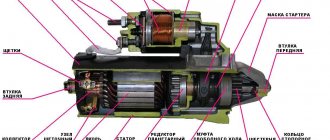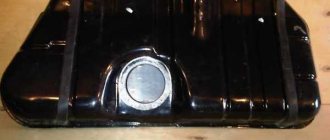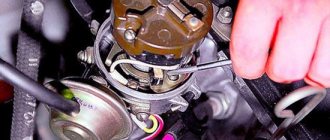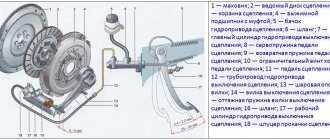Published: 10/30/2020
- Main elements of the exhaust system
- Choosing a resonator for VAZ 2107
- Resonator
- Location of the VAZ 2107 resonator
- Muffler VAZ 2106
- Lada 2107, 241 thousand without capital › Logbook › Replacing the VAZ-2107i injector resonator
- Basic moments
- How are knocking and muffler position related?
- Exhaust system design of VAZ 2107
- What is a muffler for?
- Differences between the exhaust systems of carburetor and injection VAZ models
- Volkswagen Jetta Chocolate shark › Logbook › Self-oil change in DSG-7 1.4 (122). Report.
- Roger Shah meets Aly & Fila and Susana – Unbreakable
- How often does a muffler need to be repaired?
- Car engine noise - elimination principle
- Symptoms of a clogged muffler
Main elements of the exhaust system
The design of the exhaust system becomes more complex, but with each new car model it includes all the same elements.
Collector
The exhaust pipe is an intermediate link between the car engine and the converter (catalyst). The collector is responsible for the removal of gases. Since in this case there is a very strong mechanical and temperature load, which can reach up to 1000 degrees, quite strict requirements are imposed on this part of the muffler. Therefore, in the manufacture of the intake pipe, only the best alloys of cast iron and steel are used.
Also, a vibration compensator (corrugation) is sometimes installed on this part, thanks to which engine vibration is damped and does not pass further through the exhaust system.
Neutralizer
The catalytic converter (or catalyst) “afterburns” unburned fuel residues and processes carbon monoxide. This element of the exhaust system is a special chamber or tank in which a ceramic or metal element in the form of a honeycomb is located. Thanks to these honeycombs, gas mixtures are purified through chemical reactions.
Now manufacturers have begun to produce multi-section neutralizers that meet all international standards, which process a wider range of harmful substances.
Front muffler (resonator)
The resonator is, in fact, one of those parts that are commonly called mufflers. This element performs the function of reducing noise, but not cleaning exhaust gases. When gases pass through the resonator, a lot of noise is created. Therefore, the internal “filling” of the front muffler consists of numerous grilles and holes that reduce the speed of escaping gases, as well as vibration. By and large, a resonator is a tank with a perforated pipe.
Front mufflers are:
- Active. Such mufflers are made of special sound-absorbing materials, and their design is simple.
- Reactive. Silencers of this type use combinations of expansion and resonator chambers.
Do not confuse the resonator with the rear muffler, as their design is very different.
Rear muffler
When we say “muffler,” we most often mean the rear part of the exhaust system. This element provides the final absorption of noise and also carries out the final removal of gases.
Unlike the resonator, the internal “filling” of the rear muffler is heterogeneous. Several chambers with special fillers are installed inside it. Thanks to the porous structure, the system of partitions and air ducts, it is possible not only to get rid of strong noise, but to reduce the temperature in the system.
Speaking of noise reduction, we cannot ignore another type of system that reduces excessive noise in the exhaust pipe.
A cross-section of a car muffler operating on the principle of noise absorption is shown in the diagram.
As in the resonator, partitions and jumpers in the form of tubes are installed here. Only in the latter are many holes of different diameters (perforation) made, and non-flammable absorbing material is laid on the sides. As a rule, basalt or kaolin wool is used for these purposes, which can easily withstand gas temperatures of 600–700 °C.
Sound waves, passing through adjacent pipes with holes, are partially scattered and damped by overlapping each other. The second part of the vibrations is absorbed by the filler, and the third is smoothed out due to partitions and a change in the direction of flow.
Choosing a resonator for VAZ 2107
Four types of resonators are installed on the VAZ 2107:
- Long section with one tank. Installed on all classic carburetor VAZ 2101-2107 with an engine capacity of no more than 1.3 liters. Catalog number - 2101–1202005.
The last two types of resonators are shortened due to the addition of an additional element - a catalytic converter. Parts for Euro 2 and 3 differ in length (spare parts for Euro 3 are shorter) and the number of mounting bolts on the flange. The second tank is missing - its functions are performed by the catalyst.
The choice of resonator depends on the specific modification of the VAZ 2107. When purchasing, you need to keep in mind the following recommendations:
- On the carburetor version with a 1.3 liter engine, you can easily install a long section with one (VAZ 2101-07) or two (VAZ 2106-07) tanks. In the second case, the sound of the running engine will become quieter, but the power will drop by about 3-5 hp. With. Shortened resonators will not work.
- Both long resonators are suitable for carburetor and injection VAZ 2107, corresponding to Euro 0. When installing a part with one tank, the exhaust noise will increase and the engine power will increase slightly. Short pipes cannot be installed.
- The exhaust system for Euro 2 is equipped not only with a catalyst, but also with an oxygen sensor (lambda probe) mounted in the exhaust pipe. For such cars, the original shortened resonator with a two-bolt flange or any long section is suitable. However, such a resonator is not suitable for the VAZ 2107 Euro - it is connected to another catalyst and differs in length.
- The exhaust system of the VAZ 2107, manufactured in accordance with Euro 3 standards, has two oxygen sensors. On the VAZ 21074 you can install the original short resonator or a long one, but with some modifications.
Once it was possible to modernize a 1.3 liter engine by increasing the displacement to 1.7 liters by replacing the crankshaft and boring the cylinders to size 82 mm. After which it was necessary to replace the “native” resonator with one barrel, because with an increase in engine power, the exhaust pipe began to roar more strongly, especially at speeds above 2500 rpm.
It makes no sense to install a resonator from other brands of cars and front-wheel drive VAZ models on the “seven”. You will have to strongly heat and bend a pipe made of refractory steel. An alternative option is to weld the resonator tank with your own hands based on the burnt-out element.
Installing long sections on the VAZ 2101-07 that comply with Euro 2 and 3 standards is advisable in cases where it is necessary to discard a failed catalyst. The latter is quite expensive, and not every car owner is ready to make a full replacement. In this case, after installing a long resonator pipe, you will have to install a snag instead of the second lambda probe or reprogram (reflash) the engine control controller.
Replacing the muffler on a VAZ 2107 injector
Differences between the exhaust system of VAZ 2107 cars with injection engines:
- The exhaust pipe of the muffler already has a flange attaching it to the converter.
- The presence of a welded sleeve in the pants into which a lambda probe (oxygen concentration sensor) is installed.
- A catalytic converter with an iron carrier is installed in place of the additional front muffler.
- An additional muffler is installed, with a flange at the end of the front pipe.
- To compensate for bending loads when the engine oscillates, the converter flange is attached to the trouser flange pivotally, through a toroidal metal-graphite ring and spring-loaded bolts.
- The converter becomes very hot during engine operation; to protect the body from overheating and fire of the upholstery, a heat shield is located above the converter.
Replacing a VAZ 2107 muffler on an injection engine is not much different from replacing a muffler on a carburetor engine; if anything remains unclear to you, we recommend watching the video.
The exhaust system of classic VAZ models consists of three elements. The middle element is usually called a resonator. Any malfunction is accompanied by a roar coming from under the bottom of the car. Repairing and replacing the resonator with your own hands is quite simple. In this case, the choice of a new part becomes especially important - the manufacturer installed several types of resonators on the VAZ 2107, depending on the type of engine and power system.
Resonator
Resonator - a part of the exhaust system that dampens sound vibrations after gases exit the combustion chamber
The main task of the resonator is to dampen the sound vibrations of roaring exhaust gases escaping from the combustion chamber. The size, shape and design of the resonator directly affect how loud the engine will be. If this part breaks, the operation of the entire exhaust system is disrupted. The car becomes noisy and the smell of exhaust enters the cabin.
The history of the appearance of the resonator in the exhaust system
The first resonator appeared on a car at the beginning of the 20th century. Reducing the noise level was the first task that the developers had to solve, since soon after the appearance of production cars, pedestrians became dissatisfied with their excessively noisy work. This part began the creation of a complete exhaust system, which can be seen in modern cars.
Operating principle of the resonator
Exhaust gases are generated in the combustion chamber and are discharged from the cylinder through the exhaust valve. After this, they move at high speed along the exhaust manifold and exhaust pipe. In this case, the temperature of the gas mixture is about 650 degrees Celsius, so the parts of the exhaust system are subject to serious thermal stress.
The most difficult thing to create is a resonator design for a sports car. On the one hand, it must allow a flow of gases to pass through it without creating obstacles. On the other hand, reduce the noise level
Next, the gas flow enters the catalyst, and then into the resonator, which is a cavity with one or more chambers. A pipe with small holes passes through the chambers, through which a divided flow of gases passes. Passage through the pipe promotes mutual absorption of sound waves.
Types of resonators
More complex modern resonators may have a shell with thermal insulating material between the layers. Such parts not only absorb noise, but also protect the body from heating.
Increasingly, in the automotive industry there are combined resonators that consist of two parts. The first part of the part is based on the classic design with a pipe and internal bulkheads, and the second is filled with noise-absorbing material (usually basalt fiber). Such combined resonators work more efficiently than conventional ones.
Resonator operation and problems
The resonator with a double casing lasts the longest. The material must be resistant to corrosion. Typically, inexpensive mufflers for consumer vehicles are made from aluminized steel, which is regular steel coated with a thin layer of aluminum to protect the surface from corrosion. The volume of the resonator also plays an important role. The effectiveness of its work depends on this indicator. If the volume is not enough, then when you press the gas pedal sharply, the noise will increase significantly, and the part itself may begin to vibrate.
When buying a resonator made of aluminized steel, you should remember that the low price of the product is obtained by reducing durability. The best resonators are made from stainless steel
Like any part of the exhaust system, the resonator is exposed to the harmful effects of aggressive factors: operation in a gas environment, high temperatures. Because of this, the service life of exhaust system parts is very short. Signs of a breakdown may include increased noise, the smell of exhaust gases in the car, or the presence of wisps of smoke under the bottom. In this case, it should be changed.
Resonator in motorsport
Due to its simplicity and low weight, the resonator is used in motor sports, but for these purposes the part often undergoes significant changes. As a rule, sports cars are equipped with resonators that have a more complex type of chamber that provides sound absorption and has minimal resistance, that is, it does not increase back pressure in the exhaust system. Sports mufflers are usually made from stainless steel, since it has a smoother surface (creating a minimum of turbulence in the system), and parts made from it work better in extreme temperature conditions.
Instructions for replacing the resonator
Since the resonator on the VAZ 2107 is not attached to the body, it is necessary to hold it when replacing so as not to deform the exhaust pipe.
Resonator VAZ 2107
- Tap the pipe connections and clamps with a hammer, as in the previous case.
- First of all, we disconnect the resonator from the muffler, then from the “pants”. When connecting the resonator and the receiving pipe, we proceed according to the same scheme, bend the petals, use a “liquid key” or a grinder in the most extreme case, and very carefully.
- At the point where the resonator meets the muffler, the situation is more complicated. When the pipes have become stuck, we cut off a piece of pipe coming from the resonator, then remove the remaining part from the flare using a gas wrench or pliers. Usually in this place the pipes are stuck tightly, when it is impossible to separate them, we also change the muffler
- We install a new resonator, observing its original position. If the resonator is installed incorrectly, it will start knocking on the underbody or hitting uneven roads. It is desirable that the resonator pipe running from the receiving tube to the tank be parallel to the ground
- In the same way, we align the connection of the resonator with the silencer so that the tank is parallel to the ground and does not knock on the body
Changing the “pants” (reception pipe)
When replacing VAZ 2107 pants, be sure to stock up on a new gasket between the pants and the manifold, because it is destroyed when removed. It is also recommended to replace the nuts securing the pants to the manifold. So:
- First, disconnect the pants from the resonator. If problems arise, as in the case of the resonator, given the fact that the pants are replaced less often than other parts of the muffler, and the heating temperature of the connection during engine operation is quite high, we use an angle grinder.
Mounting for a carburetor engine. Nearby is the injector pants mount
- After removing the resonator, unscrew the four nuts securing the exhaust pipe to the manifold.
Unscrew the nuts securing the pants to the manifold, take out the gasket
- Be careful not to strip the studs to avoid unnecessary work replacing them. It is recommended to immediately treat them with a “liquid wrench”, otherwise we cut off the nuts using a grinder
- Working with a grinder, we cut the nut diagonally so as not to damage the thread of the stud. Then we simply knock it down using a chisel or flat screwdriver
- When installing the pants, replace the old gasket, then screw them to the exhaust manifold
- We connect the pants with the resonator and compress the flaring using a clamp.
If after replacement the exhaust system is raised under the bottom or sags:
- First, the receiving pipe and resonator are fixed at the wrong angle. We simply rotate the resonator and achieve the correct position of the system
- Second, the engine mount sagged. We change the engine mount.
Fasteners
Separately about fasteners - suspension pads and clamps. It is recommended to change them every time you change any part of the exhaust system. So:
- If the clamp looks like new at first glance, do not forget about metal fatigue. The thread “floats” over time, the clamp no longer holds the connection tightly, exhaust gases leak through and create additional noise. You will have to crawl under the car to change one clamp, and this, you see, is extra work.
- A simple inspection often fails to assess the level of wear on cushions and rubber belts. By installing old cushions with rubber belts in place, you risk losing the muffler as a result of their breakage. Considering that the price of a pillow or belt is much less than the price of a muffler, it is better to replace them immediately to avoid unnecessary costs.
Location of the VAZ 2107 resonator
The exhaust system of carburetor VAZ 2107 consists of three sections:
- double exhaust pipe connected to the exhaust manifold flange;
- resonator;
- main muffler.
A similar system was installed on the first seven with an injector that complied with Euro 0 standards. Later, injection modifications of the VAZ 2107 appeared, produced in accordance with the requirements of Euro 2 and Euro 3, in which the exhaust tract was supplemented with a fourth section - a catalytic converter located between the exhaust and resonator pipes .
The resonator, connected at the front to the exhaust pipe or catalyst, starts under the gearbox and ends in front of the rear axle beam. The resonator tank is located to the right (in the direction of travel) of the propeller shaft. The connecting pipe coming out of the body is bent upward and docked with the main muffler pipe that goes around the rear axle. The entire structure is supported by the engine exhaust manifold flange, a metal bracket and rubber hangers attached to the bottom of the car.
Purpose and design of the muffler for VAZ 2104–2107 cars
Exhaust gases escape from the engine cylinders under high pressure and with loud noise. The muffler receives and slows down gases, converts their kinetic energy into thermal energy, smoothes out pulsations and muffles the sound, then releases the weakened exhaust into the atmosphere.
Thus, among the main functions of the muffler:
- reduction of engine noise;
- conversion of exhaust gas energy;
- safe release of gases into the atmosphere.
In everyday life, a muffler is called an exhaust tract or exhaust system. In fact, it is only one, albeit the most important, element of the fuel system. For VAZ cars with a classic layout, it consists of a reception pipe connected to the engine exhaust manifold, an additional (resonator) and a main muffler.
For VAZ cars with a classic layout, the exhaust gas system consists of a reception pipe connected to the engine exhaust manifold, an additional and main muffler
All of the above is located under the bottom of the car. The system elements - pipe, resonator and muffler - are attached to each other with clamps. The exhaust pipe is rigidly screwed to the manifold and the gearbox cover, the main muffler body is suspended from the body by rubber straps, and the exhaust pipe is suspended by a rubber cushion.
At the Politburo, the Minister of Automotive Industry Alexander Mikhailovich Tarasov made a report in which he spoke about the state of affairs in the automobile industry and spoke about the need to build a new plant using foreign experience, and Dmitry Fedorovich Ustinov, the former head of the Ministry of Defense, who oversaw issues of the military-industrial complex, objected, that having such a “defense industry”, it costs nothing to build a new plant on our own. And then Kosygin proposed building two factories - one using Soviet “patterns”, and the second - with foreigners. The idea was accepted, and as a result, two with a capacity of 220,000 cars per year and a VAZ with an annual capacity of 660,000 cars appeared.
Innokenty Kishkurno
Wheels
Muffler VAZ 2106
Today, mufflers for the “six” can be purchased in two versions: stamped and welded.
The stamp-welded muffler can be considered a classic option, since these are the models that were installed on all old cars. The essence of such a muffler is in its production: the two halves of the body are welded together, then a pipe is welded to the body. The technology is very simple, so the device is inexpensive. However, it is precisely because of the presence of welded seams that the stamped-welded “glushak” will last at most 5–6 years, since the seams will quickly corrode corrosion.
Products made using traditional technology are affordable
A sunset muffler is more durable and can last up to 8–10 years. Its production technology is more complex: a sheet of metal is wrapped around the inside of the muffler. Technology makes production more expensive.
Modern rolling technology allows us to produce high-quality and durable mufflers
Which muffler to put on the “six”
Choosing a muffler is not an easy matter. In auto stores and on the automobile market, sellers will offer a variety of models of mufflers, and at quite attractive prices:
- muffler IZH from 765 RUR;
- muffler NEX from 660 RUR;
- AvtoVAZ muffler (original) from 1700 RUR;
- muffler Elite with nozzles (chrome) from 1300 rubles;
- muffler Termokor NEX from 750 rub.
Of course, it is best to spend money on an original AvtoVAZ muffler, although it is 2–3 times more expensive than other models. However, it will serve many times longer, so the driver can decide for himself: buy an expensive one for a long time, or buy a cheap muffler, but change it every 3 years.
Original mufflers are preferable for the VAZ 2106, as they last longer and do not provide the driver with additional problems associated with maintenance
Lada 2107, 241 thousand without capital › Logbook › Replacing the VAZ-2107i injector resonator
Hello everyone, back in the winter on New Year’s Eve the resonator burned out, it was 4 years old, it was inherited from the previous owner, I changed the main muffler about a year and a half ago. I decided to wrap it with asbestos cord until spring, but after a month it burned out, so I wound it again.
Recently it became warmer, and the whipping started again - I decided to replace it.
I bought a resonator made in Tolyatti in advance; the main muffler was from the Seversky Pipe Plant, near St. Petersburg.
It turns out that there are 2 types of injector: Euro-2 and Euro-3. It differs in the bend of the flange and, it seems, in length. Before purchasing, I had to look under the car to make sure I have Euro-2, so the pipe with the flange has a bend, while for Euro-3 it is straight.
For some reason I bought a metal-graphite ring with bolts, which is used to connect the exhaust pipe and the catalyst, in my case they are not needed - the resonator with the catalytic converter has a rigid flange connection. But I think sooner or later they will also come in handy.
I prepared the tools, lubricant and sealant, there was an extra clamp left over from the last time.
With sin, I unscrewed two stuck bolts from the flanges; the clamp on the muffler came off easily, since it lubricated the threads even when replacing the muffler. During removal, the resonator flange completely came off - it was already held on by snot.
I had to unhook the muffler to disconnect the pipelines; the fastening belt broke, but fortunately I have a spare repair kit, also from last time.
The catalyst honeycomb is visible.
Just for fun, I decided to measure the thickness of the metal pipe of the new resonator - it is about 1.5 mm.
It looks well made, the seams are from an automatic machine, for some reason the article number comes from the “six”, although it seems that no injectors were installed on them.
Before reassembling, I lubricated the joints with a thin layer of graphite paste.
During installation, a problem immediately arose - the bend of the muffler began to rest against the bottom of the car - this is the geometry.
I tried this way and that, but still something stuck somewhere - either in the handbrake cable bracket, then in the cable itself, or in the shock absorber.
There was no autogen, to heat it up and bend it, I had to cut off a couple of centimeters from the tip of the resonator pipe with a grinder.
Somehow we managed to move it a couple of centimeters away from the bottom. Before the final tightening, I also lubricated all the bolts with copper grease, and on top of that with graphite grease, and installed new engravers.
I also lubricated the wire securing the muffler belt with pushsal, since everything there also rusts and you have to tear the belt with a mounting tool or saw it.
Upon inspection, it turned out that siphonage was coming from the new resonator at the place where the 2 halves were welded from a small hole of half a millimeter. It was discovered by the condensate coming out - such is the quality of production, they don’t even check the tightness of the seams.
I didn’t have time to drip it with electric welding or cover it with epoxy, I’ll fix it next time.
Subscribe! Good luck on the roads!
Price: 730 ₽ Mileage: 226,000 km
Basic moments
To replace the VAZ 2107 muffler as quickly as possible, you will need screwdrivers, a set of keys and sockets, as well as an inspection hole. If there is none, then you can raise the entire rear of the car as much as possible so that it is convenient to work under it. The main muffler is located at the rear of the car. Its edge is visible when looking at the car from behind. This element must be replaced either in case of severe deformation, as a result of which the ability to pass exhaust gases is greatly deteriorated, or if it is completely burned out, due to which exhaust gases escape from the muffler without being cleaned and noise reduced. Even if there are breakdowns or burnouts, the noise level increases many times. In this case, it is necessary to replace this element.
VAZ 2107 muffler replacement
The muffler must be changed in a certain sequence. And you need to know this. So:
- The muffler of the VAZ 2107 is replaced in an inspection hole or overpass.
- It is attached to the resonator in front of its rear axle. The connection is crimped with a metal clamp, which ensures its complete tightness.
Tip: It is recommended to tap the clamp itself and the pipe connection with a hammer, this will make it easier to separate them.
- First we remove the clamp
- Then we try to pull the muffler flare from the resonator flare with our hands; this does not always work. It is recommended to use a chisel or a wide flat screwdriver.
- Using a screwdriver, bend the flaring petals, then remove the muffler. If this doesn’t work, use a “liquid key”.
- We cut off the “petals” using a grinder, if the “liquid key” did not help. When cutting the petals, it is important to be careful not to catch the resonator pipe, in order to avoid cutting through exhaust gas damage.
- After disconnecting the muffler, remove it from the suspension straps and cushion, install a new one in the reverse order.
Remove it from the suspension straps and pillow
- We attach the new muffler to the resonator so that the resonator pipe goes into the flaring of the muffler until it stops completely.
- Then we crimp the connection using a clamp.
- Replacement of the rear muffler of the VAZ 2107 is completed.
How are knocking and muffler position related?
If the muffler suddenly starts knocking on some parts of the car, find the source of the extraneous sounds. Usually the reason lies in stretched rubber fasteners. After replacing them, the knocking will stop.
Sometimes a knock appears after work related to removing the muffler. In this case, extraneous sounds are a consequence of installation errors. Round pipes at the joints with clamps can be slightly rotated relative to the correct position: more or less than required, pushed into each other.
To eliminate knocking, restore the optimal position of the exhaust system elements.
Sagging mufflers can be “treated” using similar methods—by replacing rubber bands and correcting the position of joints.
The nuances of muffler repair
The muffler of “classic” VAZ cars, according to the manufacturer’s recommendations, cannot be repaired. If a malfunction occurs in any element of the exhaust tract, the part must be replaced with a new one.
In fact, motorists often prefer to repair holes burned in the muffler - the most common defect - by welding.
The occurrence of “fistulas” is indicated by a change in the sound of the engine and the appearance of smoke from under the car. To troubleshoot, place the machine on a platform and inspect the elements of the exhaust system.
If the cause is a burnt gasket, remove the muffler and replace it. When you have an assistant, you can do without removing all elements of the system. Proceed in the following order:
- Unscrew the pipe fastening to the gearbox.
- Unscrew the nuts securing the exhaust pipe to the manifold.
- Together with an assistant, pull the “pants” off the pins while simultaneously rotating the bend of the resonator pipe.
- Replace the gasket, install the pipe in place, tighten the fasteners.
Replacing a burnt muffler gasket eliminates extraneous sounds from the engine
A welded muffler usually lasts less than a new one. But welding is also cheaper than buying. Usually, if it is necessary to repair a muffler by welding, they turn to professionals. If you have the equipment, you can do the work yourself. For this you will need:
- welding machine;
- blanks for patches made of sheet metal 1–2 mm thick;
- a piece of pipe of the same diameter as the failed one;
- grinder with cutting disc for metal;
- metal brush;
- sandpaper;
- heat-resistant paint for metal.
To repair the muffler, follow this sequence:
- Remove the muffler from the vehicle.
- Using an external inspection, determine the location of the malfunction and the extent of the damage.
- If there is a large hole in the muffler body, evaluate the condition of the internal parts. It is possible that repairing the external surface will not bring the desired restoration of the functions of the muffler without replacing the internals. In this case, it is advisable to contact professionals or simply replace the faulty part with a new one.
- Cut out the burnt area. From the blank, make a patch larger than the damage. Weld the patch over the hole with a continuous seam.
- If there is damage at the junction of the pipe and the muffler body, cut out the defective area, replace the damaged part of the pipe, and weld the repaired pipe to the muffler with a continuous seam.
- Clean the repaired muffler from dirt and rust, paint the part with two layers of heat-resistant paint.
Photo gallery: muffler welding
Video: repairing a VAZ muffler by welding
Replacing and repairing a muffler is a dirty and time-consuming job. But there is nothing complicated about it. You never know what you can do till you try.
Probably, many readers have had the opportunity to see a roaring car passing them on the road. Sometimes this phenomenon is caused by the car owner installing a pseudo-sports direct-flow muffler, but most often the problem lies in a malfunction of the resonator. What is a muffler resonator, we will find out below.
The resonator is an important part of the exhaust system. Structurally, it is a cavity divided into several chambers. A pipe passes through them with holes made in it. Passing through them, the flow of exhaust gases is divided, which helps suppress sound waves, and as a result, exhaust noise is reduced.
Since all muffler elements are subject to severe thermal loads (exhaust gas temperature exceeds 600-650°C), they do not last very long. Since the resonator cannot be repaired, in case of malfunction it must be replaced with a new one. Today we will talk about this procedure using the example of a VAZ-2107 car.
Where is the resonator located and when should it be replaced?
The resonator is installed under the bottom of the car, between the exhaust pipe and the rear of the muffler.
If we talk specifically about the “seven”, then below is the corresponding photograph (the blue arrow points to the resonator). It should be noted that some resonators have a 2-piece design. The first of them is a regular part, and the second is filled with sound-insulating material, as a result of which the exhaust becomes much quieter. But the VAZ-2107 is equipped with a simple, single-section resonator.
Exhaust system design of VAZ 2107
Like most passenger cars, the VAZ 2107 has an exhaust system consisting of three main parts:
- a receiving pipe into which gases enter from the exhaust manifolds;
- VAZ 2107 resonator (additional muffler), where gases are directed from the exhaust pipe and where the exhaust sound is partially reduced;
- muffler, which absorbs most of the engine exhaust noise.
In addition to the above parts, the exhaust system includes:
- muffler mounting pad;
- pillow bolt;
- muffler suspension belt;
- clamp bolt and clamp securing the muffler to the resonator;
- clamp bolt and clamp securing the resonator to the exhaust pipe;
- clamp bolt and clamp securing the exhaust pipe to the body;
- nuts securing the exhaust pipe to the manifold;
- pad;
- locking plate;
What is a muffler for?
Naturally, making the car sound quieter. Physically, the combustion of a mixture of air and gasoline produces vibrations of different frequencies, from low to high. The sound from the exhaust manifold carries all the energy of sound vibrations into the muffler, which is equipped with several special chambers. Like any wave, the sound from a motor has energy, or amplitude. The higher it is, the noisier the motor is. When it enters the chambers, the sound “gets entangled” and gives up its energy, turning into heat. This is why the muffler parts are so hot, although they are far from the engine, and the exhaust itself from the exhaust pipe is slightly warm. So, the first function is to make the engine quieter.
The second important function is the removal of combustion products, otherwise the mixture will not ignite in the zone of high carbon dioxide content.
The third function is keeping the cylinders clean and ventilating them.
It must be remembered that the exhaust system takes on very large thermal and chemical loads, and parts can “burn out”, since toxic exhaust gases, mixing with condensate, form complex acids, which are very aggressive at high temperatures.
On the outside, moisture, impacts from gravel, salt in winter and other causes also contribute to wear. Those who use their car in winter need to replace the muffler much more often.
What is the design of the VAZ 2107 muffler
The muffler is only part of the exhaust system. Its structure is as follows:
- Exhaust gases penetrate through the exhaust manifold into the so-called “pants” 12, which are called the exhaust pipe. The “pants” are separated from the exhaust manifold by a special gasket 11, which is designed to seal their fastening.
- The pipe is attached to the gearbox using bracket 15.
- Then there is a series of additional resonators, or mufflers, front and rear, which are attached using clamps 7 to the “pants” and 6 to the main muffler. These mufflers cut off certain sounds from high engine frequencies. Together they are called "additional muffler" 13.
- The main muffler (main) 3 is movably fixed to the bottom so that its frequency is not transmitted to the body. This mount can additionally dampen vibrations due to the “sway” of the muffler itself. It is produced using parts 1-4.
- Next comes the exhaust pipe.
Here it should be said that by the color of the exhaust and the condition of the pipe, one can draw certain conclusions about the operation of the engine, just as doctors draw conclusions about the work of the intestines by analyzing stool. For example, if you run your finger inside the pipe and a greasy, oily residue remains, then the oil scraper rings have become unusable and the engine “eats” oil, which is indicated by the black color of the exhaust. Normally, the inside surface of the exhaust pipe is dry.
The exhaust system assembly is shown below:
The main muffler contains numerous chambers consisting of perforated pipes.
The figure also shows the main muffler mounting and extension pad
An important feature of the VAZ 2107 muffler is its complete “interchangeability” with the rest of the classics. If you purchase parts from a VAZ 2101, or any other modification, you can’t go wrong
If your muffler needs replacement, it is better to do this at a service center, and purchase spare parts there so that there is a guarantee for the installation. Simply replacing a muffler is a messy business, especially if you have to start from the “pants.” It is possible that you will need to cut off the stuck joints with a grinder.
A few words about sports modifications of the VAZ 2107 muffler
A conventional muffler is indirect, this increases the pressure in the exhaust manifold and can reduce engine power. At that time, a direct-flow, sports muffler filled with ceramic fiber is able to increase engine power by faster cleaning of the cylinders from exhaust gases. It should be said that the sports muffler of the direct-flow system will never “scream”, and the engine operating volume will be quite acceptable.
Direct-flow muffler, round VAZ 2101 - 2107, standard installation
The main muffler of the exhaust gas exhaust system for VAZ 2101 - 2107 vehicles. The muffler is direct-flow. It is installed on standard mounts; a triangular flange for 3 M8 bolts is used to connect to the middle part. The muffler body is round, diameter 140 mm, length 490 mm. Filler: basalt fiber. Pipe diameter 51 mm. Made from steel 08PS. Painted black.
Attention! You will need to weld a counter flange to the middle part of the muffler. Not compatible with FOX and Clubturbo resonator.
Specifications:
Suddenly, out of the blue, while driving your favorite “Seven” in complete comfort, an incomprehensible “roar” appears at the throttle. The driver turns off the radio and listens. After every press on the gas pedal, the car growls and roars like a tank. After climbing under the bottom, it is discovered that the VAZ 2107 muffler is completely unsoldered, the pipe has moved away from the resonator, and the fastening is broken. If the inside of the exhaust pipe is “jammed” and the removal of exhaust gases is impaired due to a decrease in diameter, then the engine “chokes” and a loss of power occurs.
What to do? The muffler is hot, and it is impossible to simply connect and “wrap it” with something, since any winding will burn out. The main problem becomes somehow establishing a temporary fastening so that the muffler does not stick into a bump when you have to drive onto the country road. As a result, the driver trudges along at a speed of 45-50 km/h, stunning oncoming people, and thinks with longing about how he will drive into a sleeping holiday village on a diesel tank. So, part of the exhaust system needs to be replaced.
The above describes a common situation: many car enthusiasts do not think about the vulnerability of the exhaust system,
Few people pay attention to a serviceable muffler in a car, until a routine inspection of the chassis or rear axle reveals a hole, or a split at the seam, or a more serious breakdown.
Differences between the exhaust systems of carburetor and injection VAZ models
Installation of an injection system on a VAZ 2107 required modernization of the exhaust system. Two additional details were added to it:
- an oxygen sensor that determines the composition of the mixture, which is embedded in the exhaust manifold;
- an exhaust gas catalyst (“catalyst”), which is installed in front of the resonator, in the central tunnel under the bottom.
In connection with the installation of the catalyst, the VAZ 2107 resonator (injector) was moved a little back.
The new exhaust system has become a little more complicated, but it allows for a reduction in the toxicity of the VAZ 2107 exhaust and ensures that the car complies with EURO-2 standards.
Advantages and disadvantages of the injection modification of the VAZ 2107
The “Seven” in injection version and with a modernized exhaust system has a number of advantages over the old “carburetor” model. They are as follows:
- thanks to the injector, the engine operates more stable in all modes;
- the specific power and torque of the injection engine are higher;
- the exhaust of a VAZ 2107 with an injection system is cleaner than smoke from a carburetor engine;
- Driving a car with an injection engine is easier, it is not so demanding on the driver’s qualifications and “forgiven” mistakes when operating the gas and clutch pedals.
But installing the injector at the same time worsened some performance characteristics:
- the clearance of the injection “seven” decreased to 7 cm, which worsened its cross-country ability;
- due to the installation of the catalyst, the “survivability” of the exhaust system has decreased;
- the high temperature of the catalyst sometimes causes grass and dry leaves to ignite when the car is stopped.
Advice: to avoid fires, it is necessary to park the injection vehicle so that there is no grass or other flammable debris under it. When stopping, it is better to turn off the engine to allow the catalyst to cool down.
MALFUNCTIONS AND REPAIR OF THE RESONATOR
Resonator malfunctions include:
An annoying knock coming from under the car's bottom is usually the result of a loose exhaust pipe beating against the body and other components. The reason for this is the rubber fasteners, which wear out and stretch over time and cannot provide rigid fixation of the exhaust tract when moving. The problem is solved by replacing these fasteners.
Black soot indicates burnout of the resonator tank
Typically, exhaust tract hangers last much less than the pipe itself. Check the condition of the rubber bands at intervals of 10 thousand km; if cracks are found, immediately install new suspension mounts.
Other problems can be resolved in the following ways:
If there is a slight burnout, you can try welding the resonator tank directly on the car
Car enthusiasts with experience in welding can make a resonator tank with their own hands. To do this you should:
VIDEO: MALFUNCTIONS IN THE EXHAUST SYSTEM OF CLASSIC VAZ MODELS
Car engine noise - elimination principle
In addition to the engine, additional noise is created by tires when rubbing against the road, as well as wind flows affecting protruding structures and machine parts. But the operation of the engine creates the greatest noise effect, requiring urgent measures. And the first priority is to carry out insulation in the engine compartment.
This action, as a rule, is included in the general set of measures for the installation of complete sound insulation. However, work can only be carried out on a specific area. Insulation of the engine compartment is the most effective for the entire car and brings the noise level to the optimal level. In this case, the main task is to create a sealed coating when all surfaces of the engine compartment are treated from the inside.
In order to effectively remove car engine noise, it is necessary to adhere to a certain technology when applying materials such as vibration absorbers and, directly, sound insulation. First of all, the partition between the engine compartment and the passenger compartment is processed, as well as the inside of the hood.
Symptoms of a clogged muffler
The blockage indirectly affects all the main systems of the car - it reduces engine power, increases fuel consumption and changes dynamics. Therefore, this problem option should be considered if the machine shows signs of deterioration. Check whether the engine overheats after a short start, whether there is rust or heavy smoke outside.
When the muffler is clogged, the removal of exhaust gases produced during combustion of the fuel mixture is impaired; The natural result of this is a decrease in engine power. The problem is most often encountered by car owners whose exhaust system is equipped with a catalyst (catalytic converter), which reduces the amount of harmful emissions, but also often becomes clogged. Often, a plug occurs in the main or additional muffler, as well as in the pipes connecting them to each other, and the reason for this may be mechanical damage or destruction of internal parts.
Methods for checking for exhaust gas obstructions:
- Measure the outlet pressure.
- Determine the concentration of harmful impurities CO and CH (a measuring device is available in most car services).
- Check the pressure in the converter using an ordinary pressure gauge with a measuring limit of 0.5. The insufficient throughput of the catalyst is indicated by the maximum indicator of the device when pressing the gas pedal.
- Visually inspect the catalyst honeycombs against the light, having previously dismantled it.
Some recent cars have two oxygen sensors (Lambda Probe). In this case, you can check the effectiveness of the neutralizer based on the readings of the sensor located in the lower part (at the outlet). The electronic control unit will show an error if significant problems are detected.
